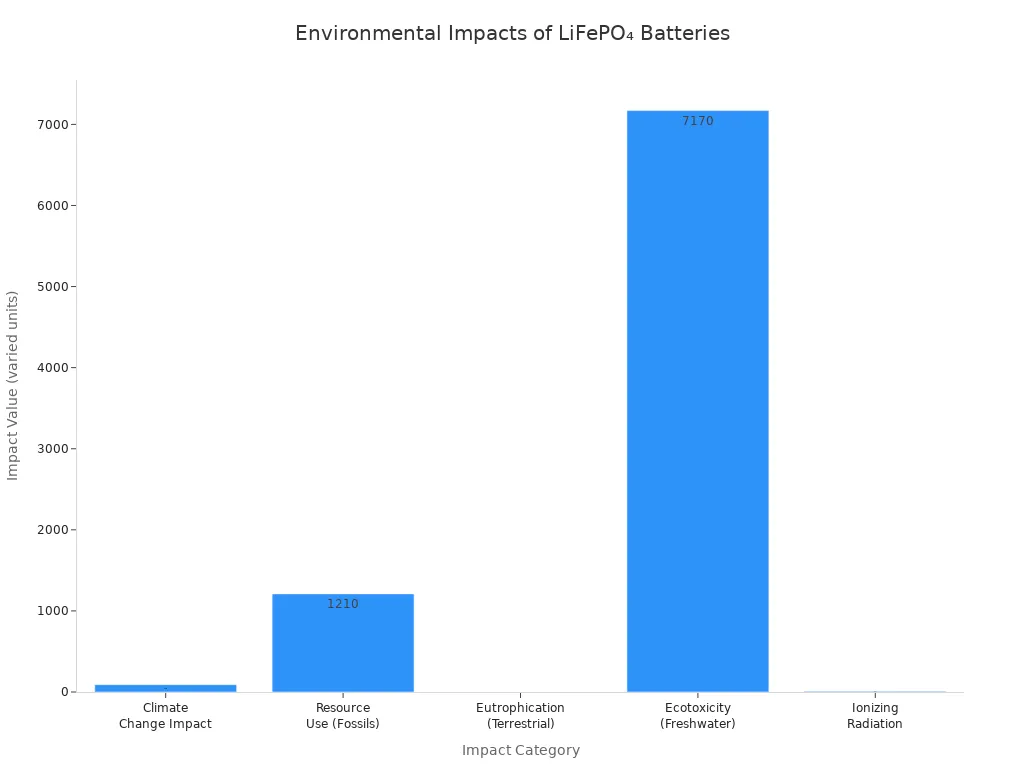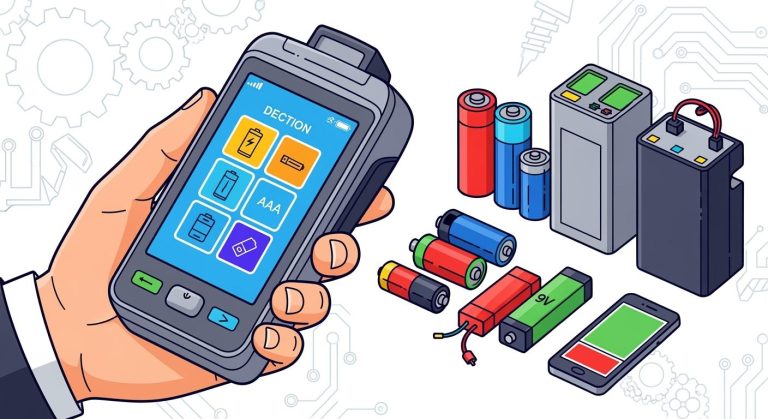LiFePO₄ batteries are engineered for large-scale warehouse applications, giving you unmatched operational efficiency. Many warehouses struggle with frequent battery changes, high labor costs, and space limits for charging. See how these challenges impact your operations:
Operational Challenge | Description |
|---|---|
Labor costs for battery changing | Swaps take 8–12 minutes each, many times daily, raising expenses. |
Downtime losses during maintenance | Scheduled maintenance causes lost productivity. |
Space allocation for storage and charging | Dedicated space for batteries may be limited. |
You gain rapid charging, a long lifespan, and sustainability with lifepo4 batteries. These batteries help you keep warehouse operations running smoothly and safely.
Key Takeaways
LiFePO₄ batteries charge quickly, allowing you to reduce downtime and keep your warehouse operations running smoothly.
These batteries have a long lifespan of 2,000 to 3,000 cycles, which means fewer replacements and lower costs over time.
LiFePO₄ batteries require minimal maintenance, saving you time and labor costs compared to traditional lead-acid batteries.
The stable power output of LiFePO₄ batteries ensures reliable performance for your equipment, enhancing safety and efficiency.
Choosing LiFePO₄ batteries supports sustainability by being cobalt-free and highly recyclable, helping your warehouse meet eco-friendly goals.
Part1: Performance

1.1 Rapid Charging
You need batteries that charge quickly to keep your warehouse running. LiFePO₄ batteries deliver rapid charging, which means you spend less time waiting and more time working. Take a look at how charging times compare:
Battery Type | Average Charging Time |
|---|---|
LiFePO₄ | 1 hour (80% charge), 2-4 hours (full charge) |
Lead-Acid | 6 to 12 hours or more |
With lithium batteries, you can use opportunity charging during breaks. This keeps your equipment ready and reduces downtime. You do not have to wait overnight for a full charge. You can reach a substantial charge in under an hour. Frequent partial charges do not harm lithium batteries, unlike lead-acid batteries. This means you can keep forklifts and other machines operational longer.
Tip: Rapid charging lets you schedule charging around your workflow, not the other way around.
1.2 High Efficiency
Efficiency matters when you want to maximize output and minimize energy waste. Lithium batteries, especially lifepo4 batteries, achieve over 96% round-trip efficiency. Some lithium-ion batteries reach a charging efficiency of 98%, with round-trip efficiency close to 87%. This high efficiency means you get more usable energy from every charge, which lowers your electricity costs and supports sustainable warehouse operations.
Lithium cell designs achieve over 96% round-trip efficiency.
Charging efficiency can reach 98%, so you lose less energy during each cycle.
You benefit from these efficiencies in battery energy storage systems, where every percentage point counts toward cost savings and environmental impact.
1.3 Reliable Power
Consistent power output is critical for warehouse operations. LiFePO₄ batteries provide stable voltage during discharge. This ensures forklifts and other equipment maintain reliable performance, even under heavy loads. The 80V LiFePO₄ batteries are designed for high-voltage applications, so you get consistent torque and control throughout your shift. You do not experience power drops that can slow down your workflow or risk safety.
LiFePO₄ cells deliver steady power, which is essential for handling massive storage capacity and maintaining precise control. You can trust your equipment to perform at its best, even in demanding scenarios.
Comparing Lithium Battery Chemistries
You may wonder how lifepo₄ batteries stack up against other lithium battery chemistries. Here is a comparison table showing platform voltage, energy density, and cycle life. This helps you choose the right battery for your needs, whether you work in medical, robotics, security systems, infrastructure, consumer electronics, or industrial sectors.
Chemistry | Platform Voltage | Energy Density (Wh/kg) | Cycle Life (cycles) | Typical Applications |
|---|---|---|---|---|
LiFePO₄ | 3.2V | 90-160 | 2000+ | Warehouse, industrial, robotics |
NMC | 3.7V | 150-220 | 1000-2000 | Medical, EV, consumer electronics |
LCO | 3.7V | 150-200 | 500-1000 | Consumer electronics |
LMO | 3.7V | 100-150 | 300-700 | Power tools, medical devices |
LTO | 2.4V | 70-80 | 7000+ | Infrastructure, grid storage |
Solid-State | 3.7V | 250+ | 1000-2000 | Security systems, future tech |
Lithium Metal | 3.7V | 350+ | 1000-2000 | Advanced robotics, aerospace |
LiFePO₄ batteries stand out for their long cycle life and safety, making them ideal for large-scale storage and battery energy storage systems in warehouses. You get durability and reliability, which are essential for massive storage capacity and continuous operations.
Suitability for Large-Scale Storage
Lithium batteries, especially lifepo₄ batteries, excel in large-scale storage applications. You benefit from:
Long cycle life, often exceeding 2000 cycles, which means fewer replacements.
Stable performance at high temperatures, reducing cooling needs.
Safety features that lower risk and support compliance.
Cost-effectiveness over time, thanks to reduced maintenance and longer lifespan.
You can install battery energy storage systems that handle massive storage capacity and maintain efficiency, even in challenging warehouse environments.
Part2: Lifespan & Maintenance
2.1 Long Cycle Life
You want batteries that last through thousands of cycles without losing performance. LiFePO₄ batteries deliver a cycle life of 2,000 to 3,000 cycles, which is roughly double that of lead-acid batteries. This extended lifespan means you replace batteries less often, saving you time and money. The table below shows how LiFePO₄ compares to lead-acid batteries in warehouse applications:
Battery Type | Average Cycle Life (Cycles) | Lifespan Comparison |
|---|---|---|
LiFePO₄ | 2,000 – 3,000 | Roughly double lead-acid |
Lead-Acid | 1,000 – 1,500 |
Several factors contribute to the long lifespan of lifepo4 batteries:
Cycle life is a key metric for utility duration.
Temperature management helps prevent damage from extreme heat or cold.
Monitoring depth of discharge (DoD) avoids excessive usage.
Proper charging methods optimize battery longevity.
Good storage conditions maintain battery health.
You see these benefits in industrial and infrastructure settings, where reliable power and long service life are critical.
2.2 Minimal Upkeep
You reduce maintenance tasks with lifepo₄ batteries. Unlike lead-acid batteries, you do not need to check water levels or clean terminals every month. LiFePO₄ batteries require no regular maintenance, freeing up technician hours for other important tasks. You also avoid frequent battery swaps, which lowers labor costs and keeps your warehouse running smoothly.
No watering or monthly checks required.
Fewer replacements due to longer lifespan.
Quick charging means less downtime and fewer daily swaps.
You gain more productive hours and reduce operational interruptions, making lifepo₄ batteries a cost-effective energy storage solution for your warehouse.
2.3 Cost Savings
You save money over the long term with lifepo₄ batteries. These batteries offer reduced maintenance costs, lower energy consumption, and improved operational efficiency. The table below highlights the main cost-saving factors:
Cost Saving Factor | Description |
|---|---|
Reduced Maintenance Costs | Minimal upkeep frees up technician hours for other tasks. |
Lower Energy Consumption | Efficient charging leads to lower monthly power bills. |
Longer Battery Lifespan | Fewer replacements needed, reducing overall costs. |
Improved Operational Efficiency | Faster charging and opportunity charging reduce downtime and boost productivity. |
LiFePO₄ batteries have a lower total cost of ownership compared to lead-acid batteries. You avoid maintenance expenses and benefit from longer operational times. This makes lifepo₄ batteries the smart choice for warehouses seeking reliable, cost-effective energy storage.
Part3: Safety
3.1 Thermal Stability
You need batteries that stay cool and safe, even when your warehouse operates at full capacity. LiFePO₄ batteries offer high thermal stability, which means they resist overheating and perform well under stress. Their structure remains stable, even during mechanical, electrical, or thermal abuse. This feature helps prevent dangerous situations like thermal runaway, which can lead to fires or explosions in other battery types.
Here is a quick comparison of thermal response and stability:
Evidence Type | Description |
|---|---|
Thermal Response | The thermal response of LiFePO₄ batteries is crucial for safety, especially under mechanical, electrical, and thermal abuse conditions. |
Stability | LiFePO₄ batteries exhibit a stable structure that resists thermal runaway compared to other lithium-ion chemistries. |
LiFePO₄ batteries are known for their high thermal stability.
They have a long lifespan and enhanced safety features compared to other lithium-ion batteries.
Although thermal runaway can occur, LiFePO₄ batteries are generally safer under high-demand conditions.
You can trust these batteries to support your battery energy storage systems, even in hot warehouse environments.
3.2 Safe Chemistry
You want batteries that protect your staff and equipment. LiFePO₄ batteries use a unique chemical structure that makes them less likely to overheat or catch fire. The cathode material is non-combustible, unlike other lithium-ion batteries that use flammable materials. In case of a malfunction, these batteries are less likely to release oxygen, which helps prevent fires.
LiFePO₄ batteries withstand high temperatures without the risk of thermal runaway.
The stable chemistry allows for excellent tolerance to overcharging and over-discharging.
You avoid toxic heavy metals, making these batteries safer to handle, store, and dispose of.
This safe chemistry makes lifepo4 batteries ideal for industrial use, especially where safety is a top priority.
3.3 Compliance
You must meet strict safety standards in your warehouse. LiFePO₄ batteries help you achieve compliance with industry regulations. Their robust design and stable chemistry reduce the risk of accidents and support safe operations. Many battery management system features monitor temperature, voltage, and current, providing real-time protection.
LiFePO₄ batteries pass rigorous safety tests for industrial and commercial use.
They are ideal for safety-critical applications, including battery energy storage systems and automated warehouse equipment.
You gain peace of mind knowing your batteries meet the highest safety standards.
Note: Always use a battery management system to maximize safety and performance in your warehouse.
Part4: Technology Integration
4.1 Automation Ready
You need batteries that work seamlessly with automated warehouse systems. LiFePO₄ batteries support automation, robotics, and IoT devices. These batteries deliver reliable power for forklifts, automated guided vehicles (AGVs), and robotic arms. You can connect them to smart battery management systems for real-time monitoring and control.
Here is how lifepo₄ batteries benefit your automated workflows:
Feature | Benefit |
|---|---|
Reliability | Provides stable, uninterrupted power, minimizing downtime and enhancing warehouse efficiency. |
Adaptability | Powers various equipment like forklifts and AGVs, streamlining operations. |
Longevity | Lasts longer, reducing the need for frequent replacements and maintenance. |
Smart Integration | Compatible with smart battery management systems for enhanced operational efficiency. |
You can learn more about battery management systems at this resource.
LiFePO₄ batteries also improve safety and efficiency in robotics and security systems. You get fast charging and high energy density, which keeps your automated equipment running longer.
4.2 Flexible Design
You want batteries that fit different warehouse layouts and equipment. Lifepo4 batteries offer flexible design options. You can choose from a range of capacities and custom voltages to match your needs:
Capacity | Voltage |
|---|---|
105Ah | Custom |
230Ah | Custom |
280Ah | Custom |
314Ah | Custom |
Modular design allows for flexible series and parallel configurations.
Supports large-scale energy needs.
You can expand your battery energy storage systems as your warehouse grows. Each battery module has a capacity of 14.33kWh. You can connect up to 15 modules in series, expanding total energy from 43kWh to 215kWh. This flexibility makes lifepo₄ batteries ideal for high-capacity energy storage in industrial and infrastructure settings.
4.3 Energy Storage Systems
You need battery energy storage systems that are easy to install and maintain. Lifepo₄ batteries feature rack-mounted designs for compact and organized installation. You save time and reduce costs with their innovative structure.
Here are the main advantages:
Advantage | Description |
|---|---|
Ease of Installation | Rack-mounted design allows for compact and organized installation, simplifying maintenance. |
Cost-effectiveness | Innovative design reduces installation and maintenance costs, making it financially viable. |
Versatility | Adaptable to various applications, ensuring scalability with energy needs. |
Long Lifespan | Outstanding durability leads to reduced downtime and lower maintenance costs. |
Safety Features | Advanced battery management system includes protections against over-voltage, over-current, and over-temperature. |
You can use lifepo₄ batteries in battery energy storage systems for robotics, security systems, and automation. These batteries help you scale your operations and maintain safety standards. You get reliable, high-capacity energy storage that supports modern warehouse workflows.
Part5: Sustainability

5.1 Cobalt-Free
You choose LiFePO₄ batteries for your warehouse because they do not contain cobalt. This decision supports ethical sourcing and improves supply chain sustainability. Cobalt mining often causes environmental harm and raises human rights concerns. You avoid these risks by selecting lithium iron phosphate chemistry.
LiFePO₄ batteries do not use cobalt, which is linked to severe environmental and human rights issues.
You help reduce demand for mining in regions with problematic practices, such as child labor.
Lithium iron phosphate is less toxic and more abundant than cobalt, making your battery solution more sustainable.
You can read more about conflict minerals and responsible sourcing in the conflict minerals statement.
The table below highlights the negative impacts of cobalt mining:
Negative Impact of Cobalt Mining | Description |
|---|---|
Soil and groundwater contamination | Harmful substances can leach into soil and water sources. |
Deforestation and biodiversity loss | Mining operations often destroy habitats. |
Harmful emissions from mining | Extraction releases pollutants into the air, affecting local communities. |
5.2 High Recyclability
You benefit from advanced recycling processes when you use LiFePO₄ batteries in your warehouse. These batteries support eco-friendly initiatives and align with green energy policies. You can choose from several recycling methods:
Recycling Method | Description | Advantages/Disadvantages |
|---|---|---|
Pyrometallurgy | Uses high temperatures to smelt batteries and recover metals. | Energy-intensive, lower recovery rates for lighter elements. |
Hydrometallurgy | Uses aqueous solutions to leach out metals, often starting with shredding. | Higher recovery rates for critical metals, lower temperatures. |
Direct Recycling | Aims to rejuvenate components without breaking down their structure. | Promises lower energy use, higher value retention, still evolving. |
You support sustainability in industrial and infrastructure settings by choosing batteries that are easier to recycle. This reduces waste and helps you meet environmental goals. For more details on sustainable practices, visit our approach to sustainability.
5.3 Green Operations
You improve your warehouse’s environmental footprint by switching to LiFePO₄ batteries. These batteries enhance efficiency and reduce downtime. You spend less on maintenance and lower your operational costs. Their recyclability supports your green initiatives and helps you comply with eco-friendly standards.
LiFePO₄ batteries produce fewer harmful emissions, creating a cleaner working environment.
You align your operations with green energy policies and reduce your carbon footprint.
The chart below shows the environmental impact categories for LiFePO₄ batteries in large-scale warehouse facilities:

You see measurable reductions in climate change impact, resource use, and harmful emissions. LiFePO₄ batteries help you achieve sustainable warehouse operations and support your long-term business goals.
You see lifepo₄ batteries solve key challenges in warehouse operations. These batteries deliver high energy density, fast charging, and long lifespan, which reduce downtime and boost productivity. The table below highlights their impact:
Feature | Benefit | Impact |
|---|---|---|
High energy density | Longer run times | Less downtime |
Fast charging | 2-hour charge | Fewer interruptions |
Long lifespan | Over 3,000 cycles | Lower replacement costs |
Lightweight | Easy handling | Better maneuverability |
Minimal maintenance | No water top-ups | Reduced labor costs |
Integrated BMS | Real-time monitoring | Improved safety |
You gain enhanced efficiency and significant cost savings.
You future-proof your warehouse by choosing batteries that support automation and sustainability.
LiFePO₄ batteries continue to evolve, driving innovation in battery energy storage systems for industrial and automated sectors. Consider upgrading your warehouse to secure long-term success.
FAQ
What makes LiFePO₄ batteries better for warehouses than lead-acid batteries?
You get faster charging, longer lifespan, and higher efficiency with LiFePO₄ batteries. These batteries need less maintenance and provide stable power. You reduce downtime and save on labor costs.
Tip: LiFePO₄ batteries also improve safety in high-demand warehouse environments.
Can you use LiFePO₄ batteries in automated warehouse systems?
Yes, you can. LiFePO₄ batteries support automation, robotics, and IoT devices. You power forklifts, AGVs, and robotic arms with reliable energy.
Smart battery management systems help you monitor performance in real time.
How do LiFePO₄ batteries support sustainability goals?
You choose LiFePO₄ batteries because they are cobalt-free and highly recyclable. You lower your carbon footprint and reduce harmful emissions.
Sustainability Feature | Benefit |
|---|---|
Cobalt-free | Ethical sourcing |
High recyclability | Less landfill waste |
Are LiFePO₄ batteries safe for industrial use?
You benefit from high thermal stability and safe chemistry. LiFePO₄ batteries resist overheating and do not use flammable materials.
You meet strict safety standards and protect your staff and equipment.
What is the typical lifespan of a LiFePO₄ battery in warehouse applications?
You can expect 2,000 to 3,000 cycles from a LiFePO₄ battery. This lifespan is about double that of lead-acid batteries.
You replace batteries less often and lower your total cost of ownership.






